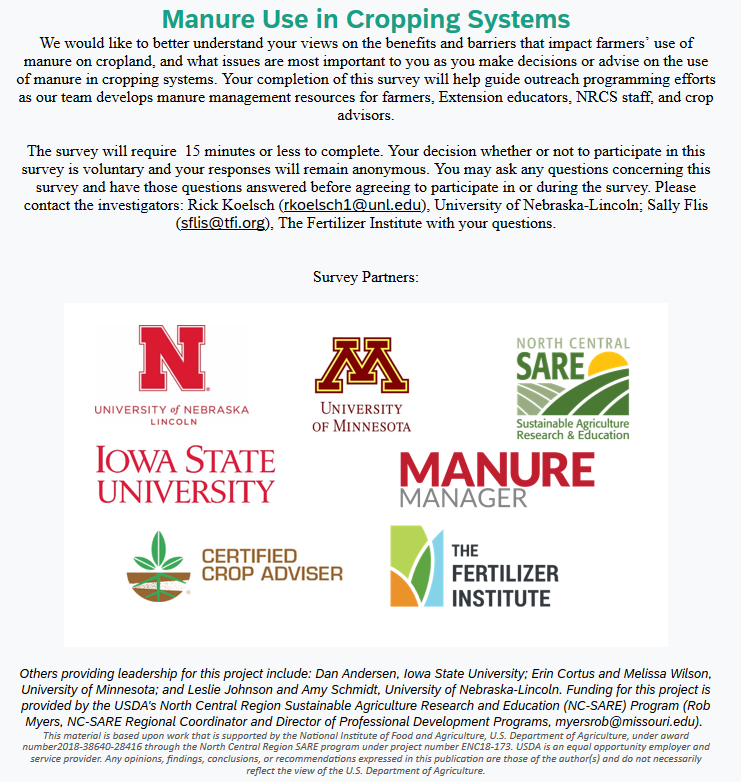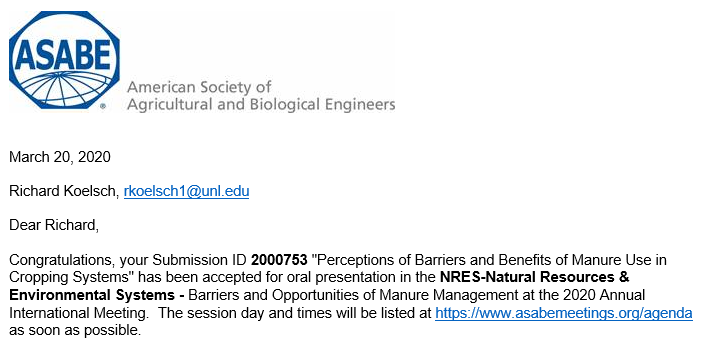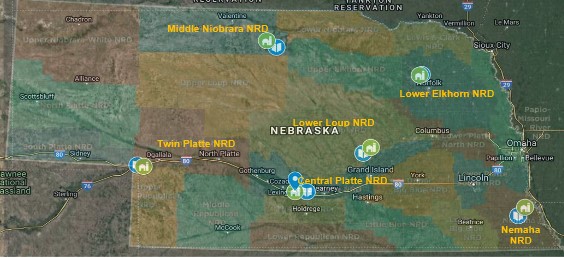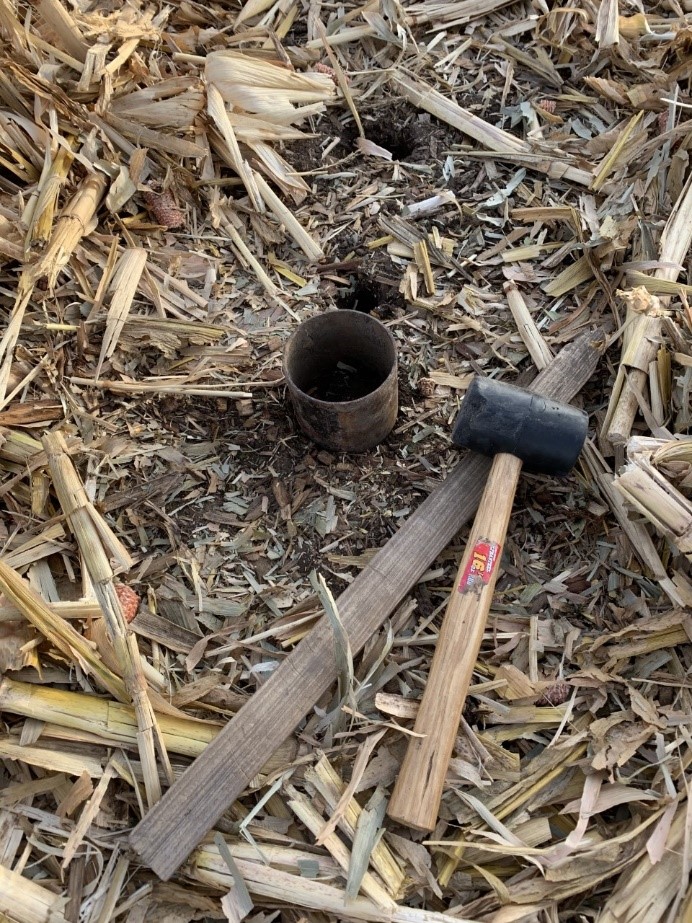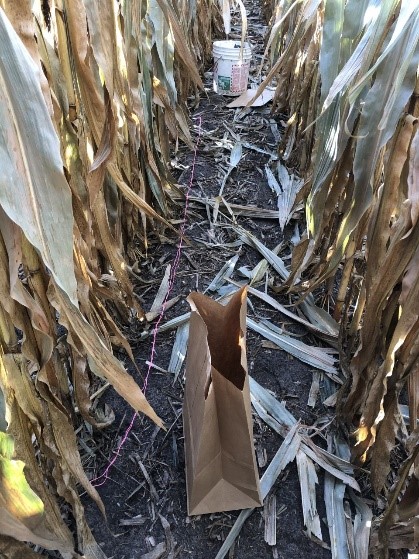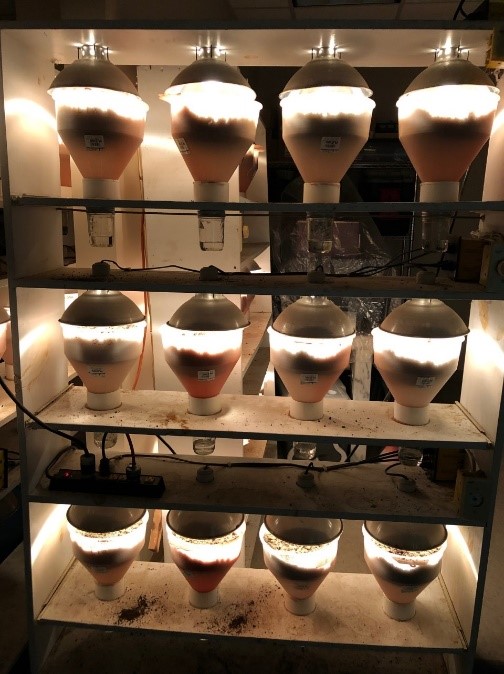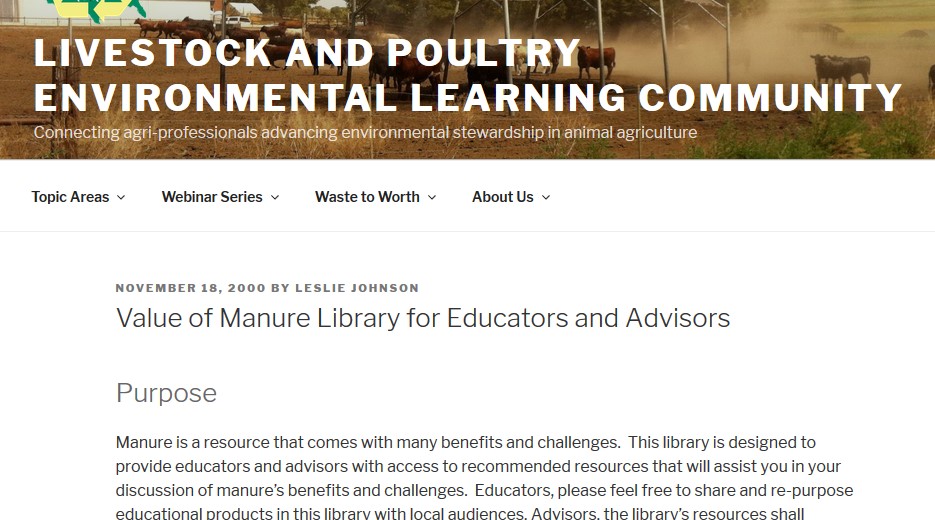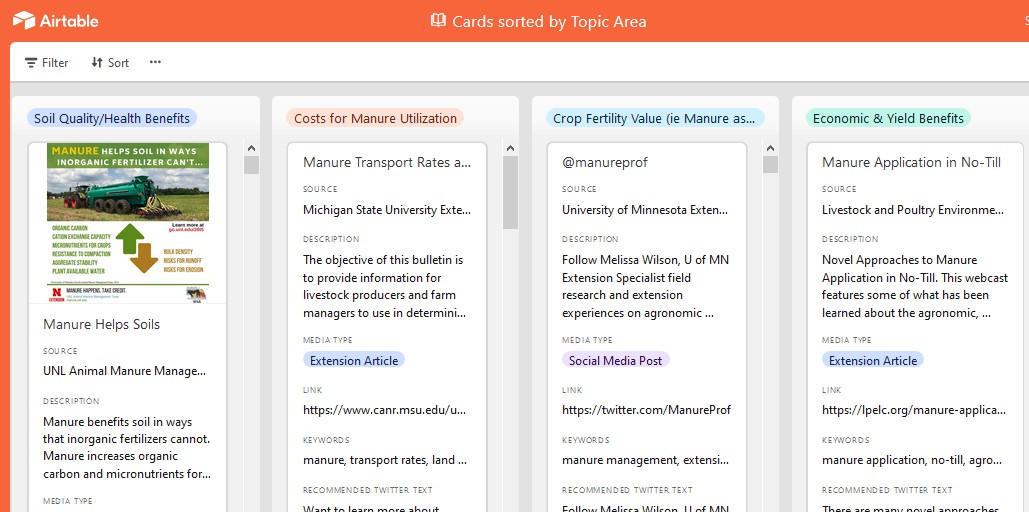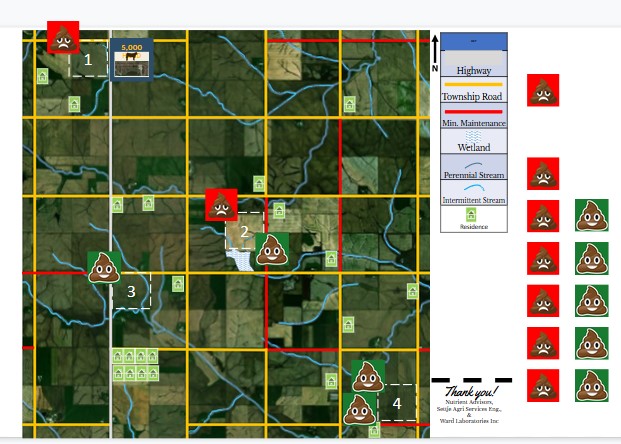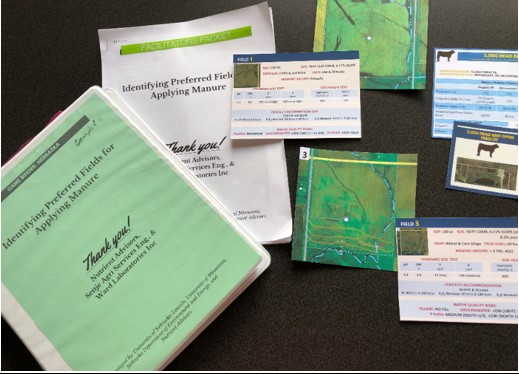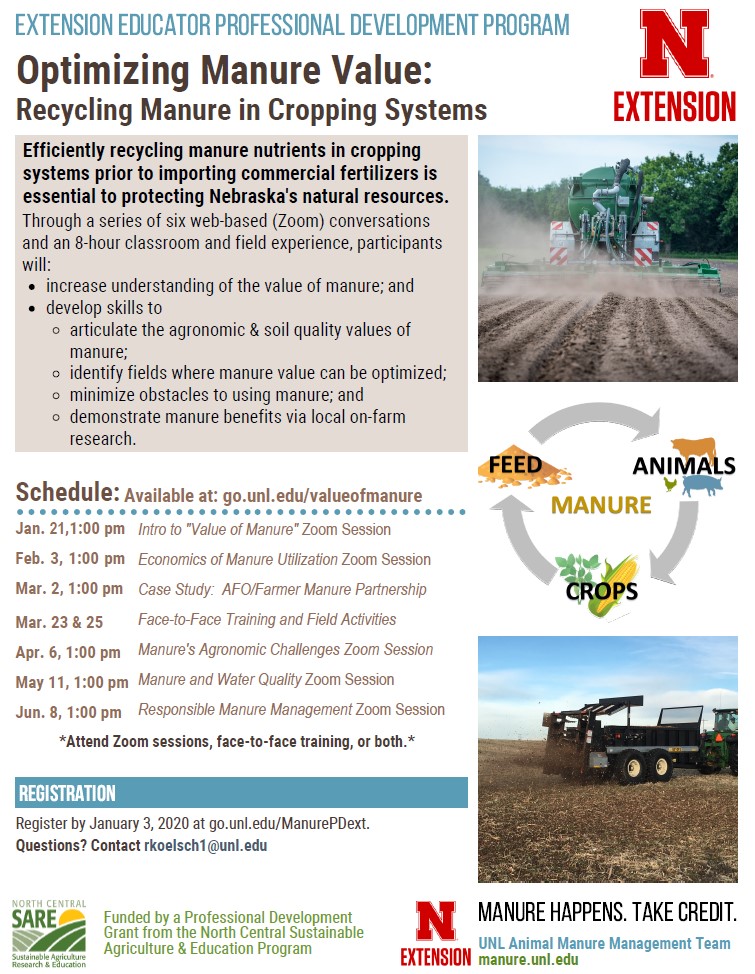Final report for ENC18-173
Project Information
LONG TERM OUTCOME
Crop farmers will experience agronomic, economic, and environmental benefits by recycling locally-available animal manure as a soil amendment on crop fields and animal feeding operations (AFO) will benefit from off-farm transfer of excess manure nutrients to neighbors.
Research has demonstrated manure's immediate value from:
1) Improved soil physical and biological properties resulting in less erosion and runoff;
2) Reduced nitrate leaching to ground and surface water;
3) Reduced fertility costs; and
4) Less imported inorganic fertilizer reducing excess nutrients in agricultural regions.
TARGET AUDIENCE
This project will target both public sector advisors (extension and NRCS professionals) and private sector crop consultants who advise crop farmers in Nebraska, Minnesota, and Iowa.
PROPOSED PROJECT
An existing multi-state working group will deliver a professional development program for those advising crop farmers intended to:
• Build awareness of manure's value;
• Demonstrate benefits locally via on-farm research; and
• Teach crop farmers to confidently identify "win-win" opportunities for manure use on cropland.
This project will utilize existing NRCS soil health field test kits and assessment metrics to deliver a curriculum addressing soil health and related benefits of manure. We will use replicated on-farm research and in-field educational experiences to encourage confidence in key educational messages.
CONNECTION TO SUSTAINABILITY
This project will support SARE's sustainability goals of long term profitability (better utilization of manure's nutrient value), stewardship of natural resources (improved water and soil quality), and quality of life for rural communities (limit risk of manure's negative qualities, such as odor).
OUTCOMES
SHORT TERM (LEARNING) OUTCOMES
MaSH team and PD participants will develop expertise and educational products in four MaSH principles:
1. Manure's benefits to soil and water quality.
2. Manure nutrient planning for replacement of commercial fertilizers.
3. Identifying win/win fields for substituting manure for inorganic fertilizer.
4. Recognizing and planning for mitigation of negative risks such as odor and soil compaction.
Crop farmers and their advisors will develop an awareness and knowledge of the above four principles and how to apply them on their operation or with clients.
Short Term Impact Indicators
1. 3 state teams piloting educational experiences on Manure and Soil Health topics.
2. Number of educational experiences delivered to targeted audiences.
3. Knowledge gain and more positive attitudes toward manure by targeted audiences of professional development grant
INTERMEDIATE (BEHAVIOR CHANGE) OUTCOMES
Three state teams and 75 professional development participants will:
• Deliver educational experiences and expert advice on the MaSH Principles.
• Implement replicated on-farm research trials and demonstrations of how to maximize manure's value to crop farmers. • Summarize on-farm research results for local validation of manure's value.
Crop farmers and advisors will pilot inclusion of manure into fertility programs with intent of achieving 4 MaSH principles.
Intermediate Impact Indicators:
1. 3 state teams implementing on-farm research and demonstration program.
2. Number of target audience participants trained.
3. Crop farmers and their advisors intension to substitute manure in "win-win" situations for inorganic fertilizers.
4. On-farm research results.
LONG TERM (SUSTAINABILITY CONDITION CHANGE) OUTCOMES
Extension and NRCS professionals will deliver sustained research and education support on MaSH Principles.
Crop farmers and their advisors will choose to use animal manure within fertility programs for situations that achieve both an economic win and a natural resource win.
Animal feeding operations will transfer greater amounts of manure off-farm to neighboring crop farmers, reducing excess phosphorus within their operation.
Less inorganic fertilizer will be imported into agricultural regions contributing to lower regional nitrogen and phosphorus excess balances.
Long-term Impact Indicators:
Given the time frame of this three year proposal, this project will not attempt to measure conditional changes resulting from on-farm application.
Cooperators
Education
This project will build capacity among Extension and NRCS professionals and private sector agricultural advisors to engage in education and advising on utilization of animal manure. The intent is to help these professionals direct crop and livestock farms towards fields that experience the greatest economic and natural resource benefit from manure. To accomplish this goal, our project is:
- conducting a comprehensive needs assessment of farmers and their advisors understanding of the benefits and barriers to manure use;
- creating practical on farm research models for local implementation to assess manure's fertility and soil health benefits;
- assembling a "Value of Manure Library" of recommended educational and decision making tools for use by public and private sector educators and advisors; and
- hosting professional development in Nebraska, Iowa, and Minnesota to encourage local application of the above resources.
Education & Outreach Initiatives
Establish a stakeholder advisory team to guide the model educational experience and curriculum, ensuring relevancy to peers.
Stakeholder Advisory Committee
- A stakeholder advisory committee was assembled to help set a direction for this project and to help us target the educations messages most critical to the industry. The committee is chaired by Boone McAfee, director or research for the Nebraska Corn Board, and includes 13 individuals from our three state region. A listing of members of the advisory committee is provided in Appendix A.
- An initial March 21, 2019 conversation was hosted with the advisory group with the intended outcome of capturing the advisory group’s experiences and perspectives for the following questions.:
-
- What are the barriers to manure utilization?
- What do farmers value most from animal manures?
- What are the services and education that would be helpful in decisions to utilize animal manures?
- Is this project delivering appropriate resources to support those services and education? (likely part of our longer term conversation)
The conversation produced an extensive set of notes that were summarized for each of the questions. Each identified benefit and barrier to manure use was identified as important to one or more of four audiences (crops farmer, livestock farmer, neighbor and public policy participant).
- Benefits were perceived or experience by the stakeholders specifically to four topics: 1) agronomic, 2) soil quality, 3) economic , and 4) water quality. However, generally agreed that many of these benefits are not commonly understood by many members of rural communities. A more extensive listing of “barriers” were identified by the stakeholder group that were generally summarized into topics of 1) logistics of manure access, 2) regulatory scrutiny, 3) agronomic shortcomings of manure, 4) neighbor or rural community concerns, 4) economic limitations, and 5) unrecognized benefits of manure. In addition the group identified critical educational needs or services important for encouraging manure utilization that targeted 1) guidance for crop producers making agronomic planning decisions, 2) guidance for crop farmers specific to integrating manure into a fertility program, 3) guidance to those brokering or advising on manure use, and 4) general public information design to provide an un-biased summary of community benefits and risks.
- The stakeholder advisory group again met in August 2019 to review and pilot test a Manure Use in Cropping Systems needs assessment survey that will be discussed in greater detail below.
- An additional conversation was held with 12 practitioners (NRCS and Extension professionals, private sector advisors and service providers) at the April 2019 Waste to Worth conference. This conversation helped us further refine our understanding of the same questions raised with our stakeholder advisory group.
Needs assessment survey
- Following the previously discussed stakeholder and practitioner conversations, the leadership team agreed to construct a needs assessment survey based upon input from the advisory group. Specifically, a need was identified to 1) separate out the “challenges” associated with manure from the “true barriers” that prevent manure utilization and 2) further refine our understanding of different audiences’ specific perceptions of manure’s benefits, challenges, and service requirements. We also encountered a shared interest in gathering this same data in conversations with American Agronomy Society Certified Crop Advisory program, Manure Manager magazine, and The Fertilizer Institute.
- The resulting survey (http://go.unl.edu/manure) was tested with several group and then released in December 2019 and promoted through February 2020 (see survey’s introductory page in Figure 1).
Figure 1: Open page of the Manure Use in Cropping Systems survey
- Data was reviewed, summarized, and an initial summary of findings published in Fall 2020 by Manure Manager magazine, the ASA Crops and Soils magazine, and others. In addition, a presentation and paper was delivered at the 2020 International ASABE Conference (see Figure 2).
Figure 2. Acceptance of proposal for presentation of survey results to 2020 ASABE International Conference.
Of the 1,140 survey responses that were initiated, 957 (84%) were completed. Results were heavily weighted towards participants from the Corn Belt and the High Plains regions of the United States (67%) with other regions of the U.S. and Canada represented by 21% and 12% of respondents, respectively.
Year 1 Targeted Educational Messages.
-
Based upon stakeholder advisory committee conversation, the Waste to Worth stakeholder conversation and the professional judgement of our leadership team, we agreed to target these educational topics during year 1:
For Crop Farmers and Their Advisors
-
- Benefit - How do I pick fields that gain the greatest economic value from manure’s nutrients?
- Benefits - What are the soil health benefits from manure? Are there economic benefits that will result?
- Barrier – How do I minimize the nuisance and odor risks my neighbors will experience when I use manure?
- Barrier - What does it cost ($’s, time & timeliness) to utilize manure?
- Barrier - How do I predict the reduction in inorganic fertilizer application when I apply manure? Are there complimentary roles for manure and fertilizer?
- Barrier – Are there environmental benefits for use manure that I can discuss with my neighbors?
For Rural Communities
-
- What best practices should I expect for land application of manure to protect my property?
- Good, Bad, and the Ugly for manure use and water quality protection in my community?
- Recycling local nutrients vs importing additional nutrients
For Animal Feeding Operations and Their Advisors
-
- Benefit - How do I pick fields that gain the greatest economic value from manure’s nutrients?
- Benefits - What are the soil health benefits from manure? Are there economic benefits that will result?
- How do I pick a fair value for the manure I wish to sell?
- Barrier – How do I minimize the nuisance and odor risks my neighbors will experience when I use manure?
- Barrier - How do I predict the reduction in inorganic fertilizer application when I apply manure? Are there complimentary roles for manure and fertilizer?
Key results of the survey and associated actions by the project team include:
- Crop farmers and private sector advisors recognize the complementary role of manure and fertilizer in a fertility program at 74% and 76% frequency and at slightly higher rates than all survey responses (71%). The complementary role of manure and fertilizer was also similar across regions (Corn Belt – 70%; High Plains-69%; all other regions – 74%).
- Both private sector advisors and crop farmers shared similar positive impressions of manure’s benefits for crop fertility, yields, and soil characteristics. However, Farmers and their advisors all have very low recognition and understanding of manure’s potential benefits to environmental quality. Many of the soil quality benefits also produce water quality benefits in the form of reduced runoff and erosion. However, an extended history of regulation of manure to protect water quality likely leads to negative perceptions for manure value to water quality. Helping farmers recognizing the potential benefit of manure to water quality and how it may be achieved and expanding their ability to communicate these messages to their rural communities may be an emphasis of future education.
- Education and services may need to transition to more focused issues to assist AFO managers and advisors with communication of specific messages such as 1) desirable rates/plans to best meet crop N and P needs, 2) field-by-field estimation of manure’s fertilizer replacement value and nutrients contributing the greatest value, and 3) complementary manure and fertilizer recommendations for optimum yields.
Develop, deliver, and assess a model on-farm research/demonstration educational experience illustrating manure and soil fertility and health principles for use in professional development of educators and advisors.
Nebraska On-Farm Research
- Nebraska implemented a pilot on-farm research (OFR) initiative in year 1 with the model to be applied in Iowa and Minnesota in year 2. Our activities associated with the NC SARE professional development project are leveraged with a complimentary grant from the Nebraska Environmental Trust to develop six on-farm research sites for animal manure and cedar mulch in Nebraska. This project also partners with local high school agriculture programs, local Extension professionals, and local Natural Resource District for the implementation of OFR projects and local application of resulting knowledge. The local high school agricultural programs were being exposed to concepts specific to OFR, manure management, and soil health.
- Locations of on-farm research partners and collaborating high school agriculture programs are illustrated in Figure 3. Our data collection for the project was carried out during 2020 in three sites where research was conducted during the 2019 cropping season (sites located close to Saint Paul, Pierce, and Ainsworth, NE). However, engagement with high school programs was prohibited during 2020 due to COVID-19.
Figure 3. Statewide locations of on-farm research and high school agriculture program partners.
The following summarizes data collection that was performed during the 2020 growing season:
-
- Soil Chemical Properties (Fall 2019): For all the sites, soil samples were taken up to a depth of 91 cm (36 in), in layers going from 0 to 10 cm (0 to 4 in), 10 to 20 cm (4 to 8 in), 10 to 51 cm (8 to 20 in) and 51 to 91 cm (20 to 36 in). A single sample per plot was transported to a commercial laboratory to be analyzed for nutrient content (pH, Electric Conductivity, Organic Matter, Nitrates, Phosphorous, Potassium, and Cation Exchange Capacity).
- Soil Physical Properties (Fall 2019): Bulk density was assessed for depths from 0 to 5 cm and 5 to 10 cm, using a bulk density soil sampling kit with a compact slide hammer. Sorptivity measurement was completed to determine initial water infiltration in the soil (Figure 4). Wet soil aggregate stability was measured from soil samples were collected in each field and processed using the wet-sieving method.
- Crop yield (Fall 2019): Corn harvest was carried out using regular combine harvesters owned by the farmer partners, in 3 of the research sites. For the remaining site, a hand-harvest protocol was implemented; the surface area corresponding to the 1/1000th part of an acre was collected (Figure 4).
Figure 4. Metal ring utilized in sorptivity measurement (left), and implementation of hand-harvesting protocol for one of the research sites (right).
- Soil Physical and Biological Properties (Summer 2019): Each active on-farm study site was visited at least once during the summer months to collect data around the impact of treatments (manure, cedar mulch and coal ash) on soil biology. Soil samples have been taken in each of the sites to extract, enumerate and identify soil arthropods (Figure 5). A training on identification of soil arthropods was provided by Dr. Julie Peterson (Faculty member in the UNL Department of Entomology) for students and staff working on the project to extract, enumerate and identify soil organisms that can be affected by the treatments under study.
Figure 5. Berlese funnels for soil arthropods extraction.
Minnesota and Iowa On-Farm Research
- Both Iowa and Minnesota established OFR at cooperating farms during 2021 with replicated plot layout and manure applications conducted during spring 2021.
Guidance for Local On-Farm Research Implementation
In lieu of a "textbook style" guidance document on OFR implementation, team members developed an extensive, publicly available database of content related to OFR principles, outreach messaging, etc. that is available through lpelc.org.
Analysis of data from the 2020 growing season at NE OFR sites revealed the following key results:
Soil Organic Matter (SOM):
- No differences were found among treatments for sites A or B.
- For site C, SOM concentration was significantly greater for the Manure and Manure+Woodchips treatments.
pH:
- No differences were found among treatments for site A.
- For sites B & C, pH was significantly greater for the Manure and Manure+Woodchips treatments.
Soil Nitrates at 0-4” depth:
- For site A, NO3- concentration was significantly greater for the Manure treatment.
- No differences were found among treatments for site B.
- For site C, NO3- concentration was significantly greater for the Manure and Manure+Woodchips treatments.
Soil Phosphorus at 0-4” depth:
- For site A, P concentration was significantly greater for the Manure, Woodchips and Manure+Woodchips treatments compared to the Control.
- No differences were found among treatments for site B.
- For site C, P concentration was significantly greater for the Manure and Manure+Woodchips treatments compared to the Control.
Soil Potassium at 0-4” depth:
- No differences were found among treatments for site A.
- For sites B & C, K concentration was significantly greater for the Manure and Manure+Woodchips treatments compared to the Control.
Water Stable Microaggregates (WSM):
- No differences were found among treatments for sites A and C.
- For site B, WSM concentration was significantly greater for the Manure and Manure+Woodchips treatments compared to the Control.
Soil Sorptivity:
- No differences were found among treatments for sites A and B.
- For site C, sorptivity was significantly greater for the Woodchips and Manure+Woodchips treatments compared to the Control.
Crop Yield:
- No differences were found among treatments for sites A, B or C.
Deliver professional development to 75 educators and advisors across three states to teach manure utilization concepts. Field demonstration programming tied to each on-farm study will be the core educational experience for professional development and a possible model for local farmer engagement.
Nebraska Professional Development
- Nebraska agreed to pilot a professional development during first half of 2020 with Iowa and Minnesota implementing their own professional development in last half of 2020 or first half of 2021.
- The Nebraska professional development consisted of 6 participant conversations (one hour remotely presented workshops) and an 8 hour face-to-face educational experience split equally between classroom and field experience. See program summary in Appendix B and sample promotional brochure for program in Appendix C.
- The Face to Face professional development purposes included:
-
- Introduce Value of Manure topics that we would like educators to incorporate into local Extension awareness and educational programs.
- Introduce educators to a model for implementing On-Farm Research (OFR) and field demonstrations focused on manure’s agronomic and soil health values;
- Demonstrate In-field activities and/or hands-on learning experience to be implemented locally with farmers.
- The purposes of the Participant Conversations included:
-
- Engage participants in conversation around targeted Manure Value topics to further enhance group’s ability and confidence relative to advising/educating clientele on these topics.
- Share experiences among participants relative to successes and challenges of engaging with local clientele.
- Encourage educators ability to use social media and local media in delivering Priority Educational Messages.
Nearly 100 individuals participated in the NE PD sessions. Key results of the program's evaluation revealed:
- Knowledge was gained or reinforced on manure's agronomic benefit/value by 96% of participants
- Knowledge was gained or reinforced on manure's soil quality benefit/value by 82% of participants
- Knowledge was gained or reinforced on manure's economic value by 96% of participants
- All participants expect to utilize the resources presented to support their advisement or educational role related to manure use in cropping systems and all planned to begin or continue assisting crop and livestock farmers with manure management decision0-making
- The outreach resources available through the Merits of Manure content library, increased knowledge of resources available to advise on nutrient management, and demonstrations of key concepts were some of the most valuable aspects of the program identified by participants.
Create an educational curriculum to support educators teaching concepts to farmers and their advisors.
Manure Value Library
- Our team assembled educational products and decision tools that can be 1) re-purposed by extension educators for use in local program and 2) accessed by those advising farmers to assist in their identifying preferred resources for Value of Manure discussions. The Merits of Manure content library (see Figure 6) is designed to accomplish these goals. Educators are encouraged to share and re-purpose educational products in this library with local audiences. Advisors are encouraged to access recommended decision tools and educational products for enriching their discussions with clientele and rural community residents.
Figure 6. Front page for Value of Manure Library
- The initial release of the Merits of Manure library is found on the National Livestock and Poultry Environmental Learning Community web site (https://lpelc.org/value-of-manure-library/ ). The library is organized by the benefits and barriers identified by our Stakeholder Advisory Committee (see Figure 7) and address:
- Manure as a fertilizer
- Manure economics
- Soil quality/health
- Water quality benefits and impacts
- Use in organic systems
- Neighbors issues
- Regulatory concerns
- Logistics
Content is also organized by 1) social media, 2) short news articles and web pages, 3) educational publications, 4) decision support tools; and 5) recommended research articles. The organization of the content in Airtable is illustrated in Figure 7.
Figure 7. Content of Value of Manure library is organized using the commercial web product called Airtable. Content can be reviewed by benefits and barriers topics (shown below) and by type of media.
Selecting Land Application Sites Curricula
- The resources of this project were leveraged with a small grant from the North American Manure Expo to create a highly interactive learning experience with the intent of creating participant discussions leading to identifying preferred fields to receive animal manures. The intent of this curricula is to help audiences think through approaches that will maximize the benefits of manure application to a field and minimize the challenges associated with manure.
- A large 40” by 40” tabletop map (see Figure 8) was created with supporting resources (Figure 9) with several Animal Feeding Operations species options and four alternative manure application sites that can be placed on the map. Six to eight participants are gathered around the map and collectively decide which fields would be preferred for applying manure. The curriculum guides the participants through various exercises and discussions leading to placement of “Happy Manure Emojis” and “Sad Manure Emojis” that help the participants think through the benefits and challenges of each field. Planned exercises target answering these questions:
-
- How far will manure need to be transported to agronomically use the nitrogen and phosphorus in the manure?
- Which field will gain the greatest economic return from manure’s nutrients?
- What is the cost of transporting manure to each field?
- What are the higher water quality risks associated with each field?
- Which fields will benefit most from soil health improvements?
- How do I use a weather forecast to avoid an “odor inversion” that may impact neighbors?
Figure 8. Tabletop map used as the game board for discussions of how to maximize manure’s benefits and minimize its challenges.
Figure 9. Supporting resources for the Selecting Land Application Sites curricula.
These interactions regularly lead to additional discussion among participants relative to other decision factors such as local infrastructure, logistics of moving manure longer distances, etc.
A team of four extension field educators, two extension specialists, two regulatory agency representatives, a private sector advisor, and a graphic art specialists teamed up to produce and pilot test this map with 100 animal feeding operation managers in Nebraska and 100+ manure applicators in Minnesota during fall 2019 and winter 2020.
The exercise has since been delivered during Nebraska Land Application Training programs in 2021 and 2022 to nearly 200 permitted AFO operators.
Upon completion of this project, over 200 pieces of content were created and integrated into the Merits of Manure content library. While analytics describing downloads and views of individual pieces of content are not possible within the platform utilized, general Google analytics for the site indicated frequent and sustained access of the content by users. Likewise, direct communications by users illustrate the value of this tool. An NRCS State Soil Health Specialists commented, "I'm not sure we have talked since the development of this awesome initiative. I wanted you to know that I appreciate your emails, the new content and the reminder it serves for me to spread the Word [about spreading manure]! I have used many of the promo cards and picture graphics you have shared in my NRCS presentations. These are great. Keep up the good work."
Establish project working groups to a) lead state professional development implementation, b) design and develop the MaSH curriculum, and c) guide application of on-farm research/demonstration to this topic.
Work Groups
|
On-Farm Research |
Curriculum/Library |
Stakeholder Advisory |
|||
|
Name |
Institution |
Name |
Institution |
Name |
Institution |
|
Amy Schmidt |
University of Nebraska - Lincoln |
Erin Cortus |
University of Minnesota |
Boone McAfee |
Nebraska Corn Board |
|
Melissa Wilson |
University of Minnesota |
Dan Anderson |
Iowa State University |
Andy Scholting |
Nutrient Advisors |
|
Aaron Nygren |
University of Nebraska - Lincoln |
Mike Kucera |
NRCS National Soils Lab |
Rick Koelsch |
University of Nebraska - Lincoln |
|
Aaron Hird |
NRCS (NE) |
John Gilley |
USDA ARS |
Amber Saylor Mase |
University of Wisconsin-Extension |
|
Laura Thompson
|
Nebraska Extension On-Farm Research |
Anne Nardi |
University of Wisconsin-Extension |
Farmers, AFO managers, advisors (see Appendix A) |
|
|
Jacob Ness |
NCGA Soil Health Partnership |
Rick Koelsch |
University of Nebraska - Lincoln |
|
|
|
Agustin Olivio |
UNL Graduate Student |
Ann Lewandowski |
Minnesota Office of Soil Health |
|
|
N/A
Documents supporting previously discussed deliverables.
Appendix A: Participants in Stakeholder Advisory Committee.
|
Name |
Information |
|
Nebraska |
|
|
Boone McAfee, Advisory Group Facilitator |
Director of Research, Nebraska Corn Board (chair of stakeholder advisory group) |
|
Andy Scholting |
President, Nutrient Advisors. |
|
Steve Peters |
Crop farmer who utilizes beef manure in fertility program |
|
Walt Traudt |
Clay Center, NE (hog operation with Maschhoffs). |
|
Tyler Weborg |
Young feedlot manager that markets significant manure quantities |
|
Robert Turek, SVP Feed Division |
Agronomist with Central Valley Coop |
|
Minnesota |
|
|
Rick Gilbertson |
Independent Agronomist |
|
Chad Davison |
Crop farmer (adding manure into his planning in next year. Interested in irrigation application) |
|
Matt Ringhand |
Crop farmers |
|
Mr. Czech |
Dairy farmer (works with Schlichtings) |
|
Mike Kloss |
Prairie Farms in Rice, MN (works closely with Ringhand) |
|
Iowa |
|
|
Gary Brown |
Crop, cattle, and swine farmer |
|
Representative of Iowa Select |
|
|
Eric Phipps Farm Nutrients |
Manure broker company as well as retailer for other fertilizers. |
Appendix B: Professional Development Agenda - Nebraska
Professional Development Session (8 hour classroom and field experience) Purpose:
- Introduce Value of Manure topics that we would like educators to incorporate into local Extension awareness and educational programs.
- Introduce educators to a model for implementing On-Farm Research (OFR) and field demonstrations focused on manure’s agronomic and soil health values;
- Demonstrate In-field activities and/or hands-on learning experience to be implemented locally with farmers.
Participant Conversations (six one-hour distance delivered sessions) Purpose:
- Engage participants in conversation around targeted Manure Value topics to further enhance group’s ability and confidence relative to advising/educating clientele on these topics.
- Share experiences among participants relative to successes and challenges of engaging with local clientele.
- Encourage educators’ ability to use social media and local media in delivering Priority Educational Messages (shown below)
Face to Face Agenda
Classroom Experience - March 23 12:45 to 3:30 PM
|
Topic Area |
Time |
Lead Facilitator |
|
Intro to Topic - Why are we focusing programming on this? |
12:45 - 1:00 pm |
Amy Schmidt |
|
Manure Nutrient Management - Nebraska’s recommendations |
1:00 - 1:30 pm |
Melissa Wilson and Rick Koelsch |
|
Economics of Manure - What Makes Manure Valuable? |
1:30 - 2:00 pm |
Erin Cortus, Tyler Marotz, and Rick Koelsch |
|
Manure and Soil Quality. What are the soil benefits that result from manure? |
2:00 - 2:30 pm |
Charles Wortmann |
|
Identifying preferred fields for receiving manure (Table top maps exercise) |
2:30 to 3:30 pm |
Todd Whitney and Michael Sindelar |
Field Demonstration (March 24 for all Non-Extension Participants. March 25 for Extension Educators.)
|
Introductory Comments: Opportunities for Engaging Local Audiences |
8:00 to 8:15 AM |
Leslie Johnson and Agustin Olivio |
|
Manure & Soil Health Field Demonstration Opportunities ● Manure impact on infiltration and runoff - rainfall simulator demonstration ● Slake Test, Slump Test, Cotton Fabric Test, and Soil Microscopes |
8:15 to 8:45 AM 8:45 to 10:15 AM
|
Aaron Hird and Agustin Olivio Amy Schmidt, Agustin Olivio, and Leslie Johnson |
|
Break |
10:15 to 10:30 AM |
|
|
On-Farm Research: ● Protocols for comparing manure and fertilizer ● In-field setup of on farm trials ● Collecting and summarizing field results |
10:30 to 11:15 AM |
Amy Schmidt, Agustin Olivio, and Melissa Wilson |
|
Applying Manure as a Fertilizer 1. Equipment considerations - What must be accomplished to insure uniform manure nutrient application? 2. Calibration options |
11:15 AM to noon |
Dan Andersen and Leslie Johnson |
|
Local Approaches to Sharing the Manure Value Message How Can We Help You with Local Education and Advising Roles? |
Noon to 12:30 PM |
Amy Schmidt |
Participant Conversations. (Six 60-minutes or less Zoom Sessions).
All workshops will include discussion of participant successes and challenges.
|
Intro to “Value of Manure” Professional Development Experience Planned |
Jan 21 |
Amy Schmidt, Rick Koelsch, Leslie Johnson, University of Nebraska |
|
Economics of Manure Utilization |
Feb 3 |
Dan Andersen, Iowa State University Andy Scholting, Nutrient Advisors |
|
Successful Partnerships for Transferring Manure Panel |
Mar 2 |
Mike Drinnin, feedlot owner with facilities near Palmer and Columbus; Matt Holt, row crop farm based near Holdrege raising corn, soybeans, and seed corn. Matt Geiser , Settje AgriServices Tim Mundorf, Central Valley AG nutrient specialists |
|
Manure Application Window of Opportunity |
Apr 6 |
Melissa Wilson, University of Minnesota Glen Arnold, Ohio State University Melanie Stock, Utah State University |
|
Manure and Water Quality |
May 11 |
Amy Schmidt, University of Nebraska John Gilley, USDA ARS Rick Koelsch, University of Nebraska |
|
Responsible Manure Management - What does that entail? Panel Discussion |
June 8 |
Cay Ewoldt, representative from Settje Agri-Services, University or NRCS representative, and Walt Traudt (pork producer) |
Appendix C: Sample promotional brochure.
N/A
Educational & Outreach Activities
Participation Summary:
Learning Outcomes
Project Outcomes
We are reporting in year 1 of a three year project. Completed outcomes are described previously. There are no impacts to report at this time.
No recommendations
